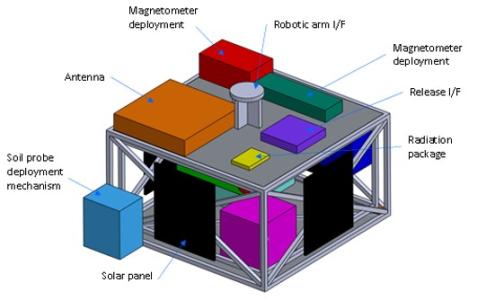Miniaturized Sensor Packages and Delivery Systems for In-Situ Exploration
Programme
TDE
Programme Reference
T314-606MP
Prime Contractor
Still to add
Start Date
End Date
Status
Contracted
Country
Finland

Objectives
Design and prototype Moon and Martian surface sensor packages for exploration missions. The activity will also investigate and prototype the payload delivery systems for Moon and Mars
Description
The activity will prototype the most critical functions of the sensor package including the following data: environmental parameters (temperature, radiation, etc), position, communications, etc. The sensor packages will be a light, robust, miniaturized set capable of surviving a high G loads, extreme thermal environment, and capable of penetrating the surface and operating from the surface. The sensor packages shall provide for data gathering at the surface of the Moon and on Mars.
It is expected that the sensor packages will share some common requirements but also some specific based on different environments and exploration objectives:
- For the Moon, the sensor package shall gather environmental parameters and asses the abundance of volatiles (water, ice) and other Lunar resources.
- For Mars, the sensor package shall gather environmental parameters (pressure, temperature, wind, dust) and also allow to the broadcasting of a radio beacon for positioning purposes.
For each case (Moon and Mars), the sensor package shall be designed according to commonalities to allow cost cutting and synergies between the two environments. For sensor packages will be sharing a common data handling and communication architecture.
The activity will also design of the delivery systems of the sensor packages. The deployment on the Moon will occur from a rover or drone, using a spring mechanism or pyro-technique. The deployment on the Mars will occur from a high altitude penetrator that will be deployed from an entry vehicle. The activity will also determine the dropping trajectory from the rover or drone in the Moon and from the entry vehicle at Mars.
The activity will provide for a prototype of the most critical functions including aspects of miniaturization of all electronics. The activity will also provide for tests that will include representative deployment, operation of sensors and actuators, wireless communication to a base station/EGSE, etc. The common electronics should use flight-like (size, mass, function) parts (microcontroller that has a space equivalent, qualifiable wireless link etc).
The outcome of the activity will need to have a maturity that allows to proceed to TRL5 within 1.5 years.
Application Domain
Exploration
Technology Domain
19 - Propulsion
Competence Domain
7-Propulsion, Space Transportation and Re-entry Vehicles
Keywords
7-Sensing & Positioning
Initial TRL
TRL 1
Target TRL
TRL 4
Public Document
Executive Summary
